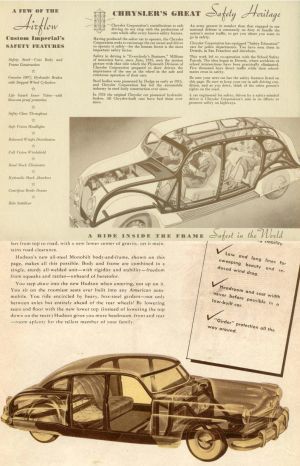- Home
- About Us
- Join/Renew
- Member Benefits
- Member Pages
- Log In
- Help
- Museum Store
Am skipping Chrysler and Nash because one walk-through of their studios by Pierce at war’s end would have scared the recon team away. Kaiser-Frasier, ditto plus uncertainty of the new enterprise. Tucker? What Tucker.
This leaves good ‘ole Studebaker, which I think might have been Pierce’s best bet despite South Bend’s post-war focus on compact cars only. In addition to the new front fenders and hood that Pierce always needed to tool, Studebaker’s body would have needed widened significantly and a new roof, decklid, rear quarters, windshield and backlight tooled.
On the plus side, Studebaker’s doors could have been used in whole or large part and its floorpan could have been widened by welding on side extensions.
From a design standpoint the Studebaker, at 61.5 inches tall, was lower than every post-war design except Hudson at 60.4 inches. The 1948 Cadillacs stood 63.1 inches tall. Lincoln, 62.7.
The new Studebakers launched as early 1947 models because Raymond Loewy’s studio, not being an OEM, was allowed to work on design during the war, and therefore got out ahead of the Big 3.
After pondering Studebaker’s odd proportions I concluded that for Pierce, the magic number was “8†with respect to increased length, width and rear overhang. Let’s look at front of Land Crusier first, Studebaker’s most expensive model. One piece windshield was a hallmark though I wonder if there was distortion at its centerline.
The second image widens the car by 8 inches while I threw in the third mostly to suggest possibilities that worked in Pierce’s side-by-side quad lamps.
Next up, lots of side views.
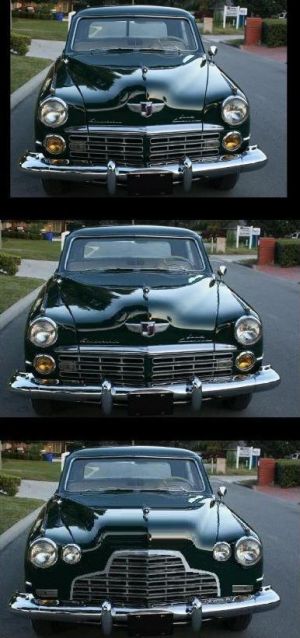
This 1948 Land Cruiser is practically identical to the ’47. The new Studebakers came in 3 wheelbases. Champion sat on 112 inches while Commander used 119 inch, mating Champion’s body to a 7 inch longer hood. Both series came in sedan, 2-row coupe and convertible and 1-row coupe with extra long deck which, like Hudson coupe, would have needed to serve as spark for Pierce studio’s imagination re: luxury sedan. Land Cruiser sat on exclusive 123 wheelbase and came in sedan form only, the extra 4 inches added to the rear doors, which also got side vent windows.
Drama clouded the tail end of the design process, Virgil Exner creating an 11th hour alternative design in his basement with encouragement and cover from certain high level management unhappy with Loewy, and being provided the correct hard points while Loewy’s studio (still in NYC, I think) was given the wrong dimensions. Management ultimately chose Ex’s clays. Loewy immediately fired Ex. Chrysler soon hired Ex.
The design, a mixed bag in my opinion, seems to have been well received at the time, very fresh. Ex generally preferred strong, upright frontal proportions and elements, which worked well in this application. He also got the flow-through front fenders right and beat GM to the punch with the bulging rear fenders, which looked good in side view if not from rear, of which more later. Rear wheels were positioned behind the rear seats, a negative aesthetically but not nearly as severe as Step-Down’s. Sedan’s C-pillar was oddly shaped as was low-cut 2-piece wrap around backlight. And of course, there was that 2-row coupe’s 4-piece backlight that wrapped all the way around to the B-pillar.
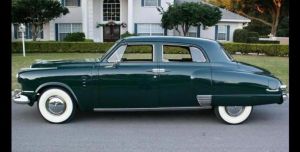
Will show two Pierce side views, first being a simple lengthening of Land Cruiser, 8 inches added to hood, 8 to rear overhang. I also increased the rake of the backlight and wrapped the C-pillar around to make it appear wider, present a more formal look and enable an aesthetically preferred one-piece backlight, albeit at expense of visibility.
Took the Harley Earl approach to chrome trim (the more, the better!) by continuing the gravel shield rearward to rear bumper, and lower chrome trim forward to front wheel. Have to wonder if Ex had wanted these too, his design including a feature line above the gravel shield extending to the rear bumper. Perhaps the bean counters concluded that Ex had requested one too many beans. Of course, for Pierce-Arrow the more beans, the better… if in good taste.

Second version, to be shown in next post, is the result of my distaste for the ugly rear that Ex created; see Land Cruiser at top of image. The bottom mod is my attempt at widening the car 8 inches as I did the front (in neither mod did I attempt to lengthen the hood or decklid). I also converted the backlight to one piece and increased its height, and duplicated that little white lens on left side of license plate to include right side, because Pierce would do such things. What is it, a back-up light?
My problem with Ex’s rear is two-fold. First, it tapers inward too severely. Second, the rear fenders feed into an ensemble of flat surfaces and lighting at the rear that do nothing but droop and drag. No wonder Cadillac added fins!
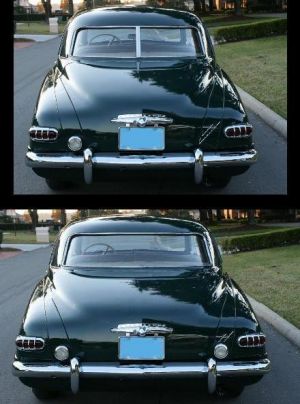
Second side view dispenses with the bulging rear fenders, favoring instead a flow-through design that continues the excellent surfacing on the front fenders and doors. I don’t think this car would have been labeled a “bathtub†as Packard and Nash (and Hudson?) were, because its proportions were much more dynamic, the car being long, low and wide with a nicely extended decklid. It would have been more like a Jaguar sedan… before Jaguar made such a sedan.
Of major benefit would have been an uplift to rear fenders relative to decklid, eliminating the flat rear look. Vertical rather than horizontal lights would have furthered this gesture. Think ’51 Packard.
The challenge would have been in keeping the rear track as wide as possible so as not to look odd like the Hudson.
A challenge for either design alternative would have been to strengthen the chassis working with not very tall frame sections. Perhaps an abundance of cross-bracing would have sufficed. The industry eventually figured it out for large cars so a solution was at hand. Would have been a good test of Pierce engineers’ metal.
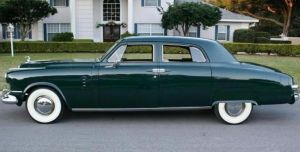
And finally, a series of images based on 119 inch wb ’47 Commander convertible, which itself was arguably the best looking Studebaker of the series.
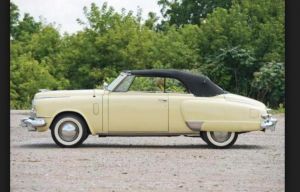
Pierce version with 8 inches added to front and rear.
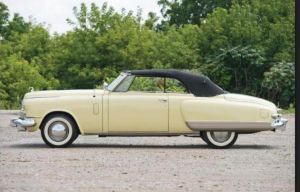
Same but with straight-through sides.
Studebaker’s lowness really shines through in these elongated Pierces. Together with a wide body would have been hot cars for the times.
Perhaps the V12 would by 1947 have been the only engine offered, with an OHV version appearing in 1951 alongside Studebaker’s OHV V8, perhaps even sharing parts.
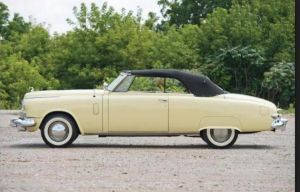
And for those traditionalists with money to burn, the classic convertible sedan using Land Cruiser’s doors and 4 inch longer body. Just in time for the 1948 election campaigns!
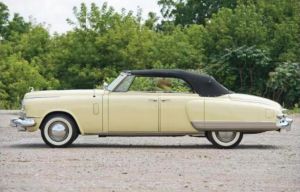
And to wrap it up, straight-through body sides.
Hope you enjoy… and imagine and share your own what-ifs, however you wish to express them!
Paul
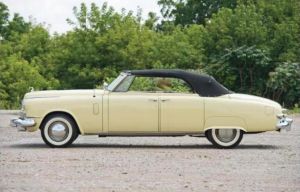
Wouldn’t it be amazing to actually see some of these designs in metal?
Paul,
Thank you very much. I have enjoyed your thread.
Ken
You’re quite welcome, Ken. Glad you enjoyed it.
Paul,
Thanks for sharing your thoughts in such a tangible manner. In my opinion,
as an owner of 4 Hudsons, Hudson and Pierce could have made the best partners. They were both obsessively conservative in engineering and very focused on quality, but occasionally did break-through developments later adopted by the entire industry.
I’ve never been a fan of the Hudson step-down bathtub sedans, but your adaption of the Coupe shape yields a very attractive large sedan to my eye. If Hudson had made such a change themselves there would probably be one in my garage next to the P-A’s and the ’49 8 step-down convertible.
Hudson’s Frank Spring could have helped with the late ’30’s and ’40’s Pierce-Arrow styling.
Unfortunately Barit led Hudson to squander it’s step-down breakthrough opportunity by emptying their bank account developing the compact Jet at the worst possible time…like the Travelodge for Pierce?!?
Sadly, both Pierce and Hudson ended up being prime examples of how NOT to run a business.
Dave
Paul,
I also really enjoy this thread. I love to daydream about the “what ifs” with various companies. Personally, I would have thought that a Chrysler takeover of Pierce would have been a good idea. Chrysler struggled for years to elevate the Chrysler Imperial, and later the Imperial, to world class status. but they never quite achieved the acceptance of Cadillac or Lincoln. They built some magnificent cars, and I much prefer them over the contemporary Lincolns and Cadillacs, and buying Pierce as their “halo make” would have given them an entry into that market. Agreed, their styling wasn’t as advanced as the other makes, but they were early proponents of body sharing. I believe most Chrysler vehicles from the late 1930s on shared base bodies, with longer hoods and front fenders for the higher end models. Both Pierce and Chrysler were engineering oriented companies, and I wonder what would have happened if Walter Chrysler had not had his stroke and carried on for a few more years in hands on control of Chrysler.
I’ve long admired the British Daimler, and feel that the Daimler Majestic and Majestic Major give an insight into what a mid 1950s Pierce might have looked like in spite of a somewhat unfortunate rear end styling.
Moving up to today, could you just imagine a Pierce V12 R/T Hellcat Roadster?
The Templar was a car from the twenties that attempted to produce a
reduced sized car with high quality, styling, and performance. The
engineers had previous employment with Chalmers, Pope-Hartford,
Stearns, Matheson, and Mercer, though it was an assembled car. It sold
for $1,950 in ’24, while a “80” sold for $2,850 in ’25. I can’t think
of any other car that had these three qualities as a design attempt. I
was 2 hours into a trip arranged prior, to purchase a Templar, when the
seller informed me he had sold it out from under me, to a museum that
specialized in Templars (the wound hasn’t healed). What if Pierce had
developed a similar entry level model (as many German Luxury Makes do
today)?
Tony,
Series 80 cars began at $2,850.00 (Runabout) and moved up in price for closed cars.
My Series 80, 7-Passenger DeLuxe Sedan was priced at $4,995.00.
The Series 80, 7-Passenger EDL with the mahogany divider sold for an additional $50.00, viz., $5,045.00.
Peter
Wonderful thoughts Gentlemen.
Dave and Ken,
I share your enthusiasm for Hudson and Chrysler, respectively. Hudson/Pierce-Arrow done right could have taken the industry by a storm in ’48 with the lowest, safest and best handling cars available, also stunning to look at. Later when the market demanded, addition of smartly designed small car, eventually the two marques becoming America’s luxury-oriented version of BMW/Mercedes-Benz.
Chrysler, like Honda decades later, got big fast through hard work and innovation, crashing the establishment’s party but always struggling to be fully accepted in the Fine Car club. Hot styling helped initially, then tepid after Airflow, rebounding in 1955 under Exner. I can’t help but see Pierce’s swagger in say, the rear of the ’61 Imperial. Sure the fenders were over the top… but weren’t those fender mounted headlights also out there? Pierce’s early advertising was probably its first styled product, the “looker†cars coming later. The company had a flair that Packard and Cadillac never quite captured. Exner seemed more fluent than most in speaking this language, see mid-Sixties interview about Duesenberg. Note that Exner also created a design for Pierce-Arrow, one of his Revival Cars.
http://bortzautocollection.com/1966DuesenbergArticle.html
With either match-up I think Pierce would have needed to bring a strong and informed voice of design. Frank Spring was more a design engineer than a trained designer as his Italia demonstrated. Even brilliant Exner was prone to big mistakes and needed an independent eye as sanity check.
My understanding is that Chrysler shared bodies through 1948 (with varying lengths fore and aft of firewall). From 1949-56, Plymouth and Dodge were narrower than Chrysler and Imperial. All were consolidated again in 1957 except Imperial, which got its own body with first use of curved side glass. Beginning in the Sixties several body sizes appeared.
Tony,
I love the Templar! Living in Cleveland 25 years ago it was one of my favorites at the Crawford museum. Agreed, there might have been opportunity. Will show a few related images soon.
Paul

Paul, we must be on the same wave length, as I owned a 1961 Chrysler
Imperial two door hardtop a few decades ago (I paid $300 for it). I
applaud your design skills and abilities with the computer.
Tony Costa
Ken,
I was incorrect about Chrysler’s body strategy for 1949-54, got confused because Dodge and Plymouth are shown in brochure to be around 3 inches narrower than Chrysler/Imperial. Not sure what drives the extra 3 inches, perhaps rear fender shape or bumpers. The ’55-56 Dodge and Plymouths are more like 5 inches narrower and appear to have their own bodies, perhaps still with some sharing underneath the sheetmetal.
Daimlers had a classic grill and similar surfacing as ’49-52 Chryslers in front fenders and flow into the front doors. Daimler height appears to allow for generous headroom just like Chrysler, would have been handsome, stately cars had Chrysler and Pierce joined forces. Got me thinking about scenario in which Studebaker refused to share after 1933 so the Buffalo buyers queried other OEMs. Would Airflow have offered chance to productionize the Silver Arrow show car? Looking at the two there are similarities but many differences. What caught my eye was cut-away of Airflow unibody… looks very similar to another unibody. Did Barit see merit in Airflow and feel there was opportunity to improve on its styling and get the height down?
